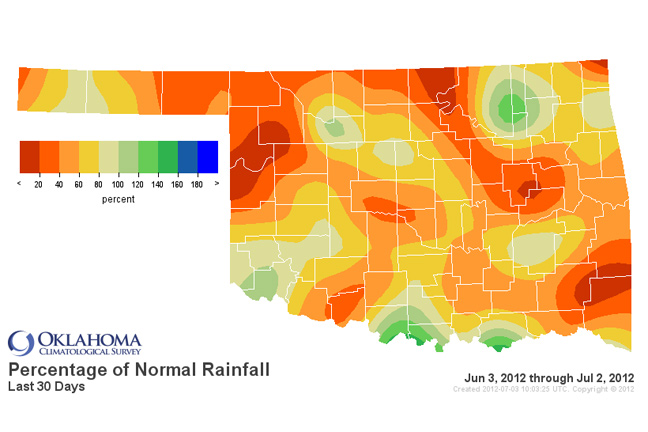
Agricultural News
Repercussions of the 2011 Drought Continue, Worsen With Decreasing Rainfall
Tue, 03 Jul 2012 13:30:06 CDT

In the July issue of the Samuel Roberts Noble Foundation newsletter, Chuck Coffey warns cattle producers that we haven't fully recovered from the 2011 drought as 2012 is now turning out dry as well.
I don't like talking about the "D-word," but the effects of the 2011 drought will be felt for years to come throughout the Southern Great Plains and the Southwest due to its severity. Limited rainfall and record heat forced the liquidation of livestock, the likes of which most of us have never seen in our lifetimes. Only the most astute land managers will recover quickly, while the majority will experience lasting effects. It may take as many as three to five years for some to fully recover and that is only if we see good years along the way.
On May 24, 2012, Gary McManus, associate state climatologist with the Oklahoma Climatological Survey said we were experiencing a "flash drought." Warm temperatures, limited precipitation, windy days and a tremendous flush of cool-season annuals worked together to rapidly remove most of the stored moisture from the soil. This combination does not bode well for the months to come. Looking at rainfall for May, south-central Oklahoma was 48 percent of normal, while the state as a whole was only 34 percent of normal. May 2012 was the fourth driest on record. Consequently, much of the state is designated as abnormally dry, which could rapidly worsen to moderate or severe drought if the trend continues. Figure 1 shows the percentage of normal rainfall Oklahoma received in May.
How can this be with all the rain we received from October through April? Here's what I think happened. From a plant's perspective, drought means slow growth or no growth. Therefore, nutrients, such as nitrogen, in the soil are not used during periods of drought and accumulate until the next rain. When we began getting rain in October of 2011, it was too late to grow warm-season perennials like bermudagrass and native grasses, while the cool-season annuals such as ryegrass and wheat took full advantage of one of their best growing seasons ever.
Although this flush of winter grass was a welcomed relief to the drought, its effects have been deleterious to the growth of warm-season perennials thus far in 2012. The cool-season forages used up available soil moisture and nitrogen, and competed against our warm-season forages. This caused the warm-season grasses to emerge later than normal in their production cycle, even though we have had what most would consider an early spring. It doesn't matter how much it rains during the winter, we still don't grow much summer grass if it doesn't rain in May and June.
What next? Drought, at least a seasonal one, should be expected in 2012. Even if it does begin raining, most of us will not see warm-season forage growth anywhere close to normal. So please make plans now for the remainder of the year.
Early weaning is one of the first lines of defense as it drastically reduces a cow's intake of both forage and water. Many have already culled their old and unproductive cows, and could be forced to begin liquidating some of their productive females in 2012. If selling cows is not one of your strategies, then secure hay resources now and plan to feed for at least six months during the fall and winter of 2012-2013.
This spring's illusion of unlimited grass is rapidly fading, and the summer of 2012 will once again prove challenging if we don't start getting above-normal rainfall.
WebReadyTM Powered by WireReady® NSI
Top Agricultural News
More Headlines...


















